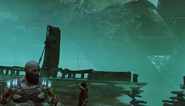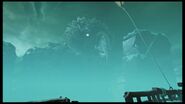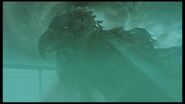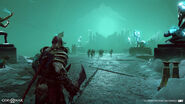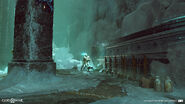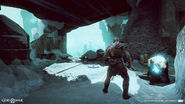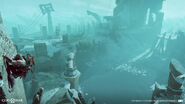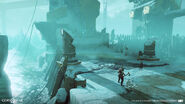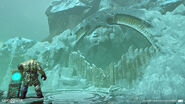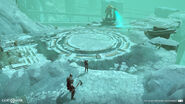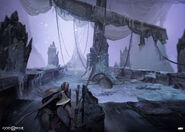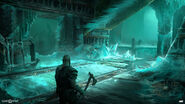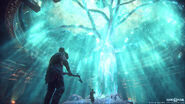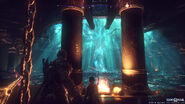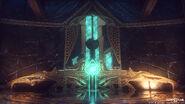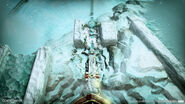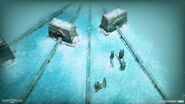Tag: Visual edit |
|||
| (26 intermediate revisions by 9 users not shown) | |||
| Line 21: | Line 21: | ||
Helheim is known as the Realm of the Dead - and the location that those who die a dishonorable death are forced to tread through the icy lands where no fire can live. It is comprised of a preliminary area and path from Tyr's Temple to the Bridge of the Damned - from which no one can return. |
Helheim is known as the Realm of the Dead - and the location that those who die a dishonorable death are forced to tread through the icy lands where no fire can live. It is comprised of a preliminary area and path from Tyr's Temple to the Bridge of the Damned - from which no one can return. |
||
| − | == Norse Mythology == |
+ | == Norse//Greek Mythology == |
In Norse mythology, '''Hel''', the location, shares a name with {{Wiki|Hel_(being)|Hel}}, a being who rules over the location. In late sources, varying descriptions of Hel are given and various figures are described as being buried with items that will facilitate their journey to Hel after their death. In the ''Poetic Edda'', {{Wiki|Brynhildr|Brynhildr's}} trip to Hel after her death is described and {{Wiki|Odin}}, while alive, also visits Hel upon his horse {{Wiki|Sleipnir}}. In Snorri Sturluson's ''Prose Edda'', {{Wiki|Baldur}} goes to Hel on his death and subsequently {{Wiki|Hermóðr}} uses Sleipnir to attempt to retrieve him. |
In Norse mythology, '''Hel''', the location, shares a name with {{Wiki|Hel_(being)|Hel}}, a being who rules over the location. In late sources, varying descriptions of Hel are given and various figures are described as being buried with items that will facilitate their journey to Hel after their death. In the ''Poetic Edda'', {{Wiki|Brynhildr|Brynhildr's}} trip to Hel after her death is described and {{Wiki|Odin}}, while alive, also visits Hel upon his horse {{Wiki|Sleipnir}}. In Snorri Sturluson's ''Prose Edda'', {{Wiki|Baldur}} goes to Hel on his death and subsequently {{Wiki|Hermóðr}} uses Sleipnir to attempt to retrieve him. |
||
| Line 30: | Line 30: | ||
== Description == |
== Description == |
||
| − | The Realm of the Dead is a land of darkness and unyielding cold, the extreme temperatures |
+ | The Realm of the Dead is a nightmarish land of intense darkness and unyielding cold, being locked in a state of permanent deep-freeze, the extreme temperatures are so lethal that even [[Odin]] himself is unable to survive there for very long. Those who die as criminals, of disease, mishap and age end up spending eternity in Helheim, where they are forever tormented by visions of their past. |
| − | The only known type of life that is able to grow in Helheim appears to be [[Hel's Bramble]], a thick, black, vine-like thorn plant that is only susceptible to the fire from the [[Blades of Chaos]]. |
+ | The only known type of plant life that is able to grow in Helheim appears to be [[Hel's Bramble]], a thick, black, vine-like thorn plant that is only susceptible to the fire from the [[Blades of Chaos]]. In addition, [[Mattugr Helson]], a [[Troll]], was also stated to have been born in Helheim, suggesting that native life is possible there if extremely difficult. |
| − | |||
| − | Throughout the realm, there are various places that can be found usually hiding rare and or unique treasures. |
||
The realm possesses dark clouds covering the skies, an emerald-colored thin fog and mist, mountains of ice, structures made of stone and human-shaped metal statues. An ever-present wind current, known as the Winds of Hel, always blows throughout the entire realm. There are spherical devices that can hold the winds, which are usually used as door locks. Despite the overwhelming cold and abundant ice, there are non-frozen rivers of water that flow from waterfalls where [[Temple of Týr|Týr's Temple]] is located. A ship there can be used to traverse these rivers. |
The realm possesses dark clouds covering the skies, an emerald-colored thin fog and mist, mountains of ice, structures made of stone and human-shaped metal statues. An ever-present wind current, known as the Winds of Hel, always blows throughout the entire realm. There are spherical devices that can hold the winds, which are usually used as door locks. Despite the overwhelming cold and abundant ice, there are non-frozen rivers of water that flow from waterfalls where [[Temple of Týr|Týr's Temple]] is located. A ship there can be used to traverse these rivers. |
||
| − | Helheim's architecture consists of bridges, gates and buildings made of black stone, most of which are covered by thick layers of ice and snow. Most of the metal statues scattered throughout the realm depict humans in lament states, and others hold wind-retaining spheres in their hands. There's also two sealed Hidden Chambers of Odin, one where the Raven King imprisoned the [[Valkyries|Valkyrie]] [[Rota|Ròta]], and one where he hid part of |
+ | Helheim's architecture consists of bridges, gates and buildings made of an ebony black stone, most of which are covered by thick layers of ice and snow. Most of the metal statues scattered throughout the realm depict humans in lament states, and others hold wind-retaining spheres in their hands. There's also two sealed Hidden Chambers of Odin, one where the Raven King imprisoned the [[Valkyries|Valkyrie]] [[Rota|Ròta]], and one where he hid part of the [[Jötnar Shrines|Shrine]] the [[Jötnar]] made about Týr. Throughout the realm, there are various places that can be found usually hiding rare and unique treasures. |
| + | |||
| + | Groups of savage undead marauders including [[Hel-Walkers]], [[Traveller|Travelers]], and [[Revenant|Revenants]] can often be found roaming the endless wastelands presumably looking for new victims or perhaps a way to escape back to the physical world. In addition other creatures can also be encountered as well such as [[Nightmare|Nightmares]] and [[Ogres]]. Because of this, Helheim is often viewed by many as being a very lawless and violent place. |
||
The souls of the deceased must pass through the Bridge of the Damned. This bridge is guarded by the Bridge Keeper [[Máttugr Helson]], a native [[Troll]] of Helheim whose job is to inspect each soul to make sure the person going past is truly dead. |
The souls of the deceased must pass through the Bridge of the Damned. This bridge is guarded by the Bridge Keeper [[Máttugr Helson]], a native [[Troll]] of Helheim whose job is to inspect each soul to make sure the person going past is truly dead. |
||
| Line 47: | Line 47: | ||
==History== |
==History== |
||
| − | Nothing is known about Helheim's history prior to the events of God of War (2018), but it seems that the realm was largely considered a lawless land for the most part. Its currently unknown exactly who ruled over Helheim before Hel eventually took charge (if there ever was anybody) but it can be assumed that there was some existing form of celestial bureaucracy in charge of running the day-to-day activities as somebody had assigned [[Mattugr Helson]] to be the Bridge Keeper. |
||
| − | |||
At an unknown point, Odin imprisoned the Valkyries in different realms. One such Valkyrie, Ròta, was trapped in Helheim. Because of the Valkyries' imprisonment, those who died in battle could not reach [[Valhalla]], thus the Realm of the Dead was overpopulated with souls, forcing many of the dead to return to the realms of the living as [[Hel-Walkers]]. |
At an unknown point, Odin imprisoned the Valkyries in different realms. One such Valkyrie, Ròta, was trapped in Helheim. Because of the Valkyries' imprisonment, those who died in battle could not reach [[Valhalla]], thus the Realm of the Dead was overpopulated with souls, forcing many of the dead to return to the realms of the living as [[Hel-Walkers]]. |
||
=== [[God of War (2018)|''God of War'' (2018)]] === |
=== [[God of War (2018)|''God of War'' (2018)]] === |
||
| − | After having his head |
+ | After having his head cut off by Kratos, [[Mimir]]'s soul briefly entered Helheim. Before his soul could pass the Bridge of the Damned, he was brought back to life by [[Freya]]. The experience apparently left Mimir deeply terrified of the dreaded realm and he had no desire to ever return there. |
In order to save his ill son Atreus, Kratos journeys into Helheim to retrieve the heart of the Keeper of the Bridge of the Damned with his Blades of Chaos. After killing Mátturg Helson and retrieving his heart, the mists of Helheim haunt Kratos with a vision of [[Zeus|his father]]. |
In order to save his ill son Atreus, Kratos journeys into Helheim to retrieve the heart of the Keeper of the Bridge of the Damned with his Blades of Chaos. After killing Mátturg Helson and retrieving his heart, the mists of Helheim haunt Kratos with a vision of [[Zeus|his father]]. |
||
| Line 80: | Line 78: | ||
* With the possible exception of [[Baldur]], [[Magni]], and [[Modi]], it is likely that most, if not all of the characters fought and killed within the game ended up in Helheim. |
* With the possible exception of [[Baldur]], [[Magni]], and [[Modi]], it is likely that most, if not all of the characters fought and killed within the game ended up in Helheim. |
||
** Interestingly, in Norse mythology, Baldur ''did'' in fact end up in Helheim after his death. Whether or not this holds true in the games' continuity is currently unknown. |
** Interestingly, in Norse mythology, Baldur ''did'' in fact end up in Helheim after his death. Whether or not this holds true in the games' continuity is currently unknown. |
||
| − | * |
+ | * It's implied that [[Mimir]]'s soul entered Helheim before he was reanimated by Freya. The experience apparently traumatized him greatly as he mentions that he had hoped to never see the dreaded realm again. |
== Gallery == |
== Gallery == |
||
<gallery> |
<gallery> |
||
| − | HelheimMapSmall.png|Map of Helheim (cropped) |
||
Helheim Eagle.PNG|Hræsvelg, Helheim's Watcher |
Helheim Eagle.PNG|Hræsvelg, Helheim's Watcher |
||
| − | God of War_20180520191341.jpg|Hræsvelg overlooking the boat |
+ | God of War_20180520191341.jpg|Hræsvelg overlooking the boat |
| − | God of War_20180520191428.jpg|Hræsvelg watches over Helheim |
+ | God of War_20180520191428.jpg|Hræsvelg watches over Helheim |
| + | Helheim - Bridge of the Damned.jpg |
||
| + | Helheim - Bridge of the Damned 2.jpg |
||
| + | Helheim - Bridge of the Damned 3.jpg |
||
| + | Helheim - Bridge of the Damned 4.jpg |
||
| + | Helheim - Docks.jpg |
||
| + | Helheim - Docks 2.jpg |
||
| + | Helheim - Docks 3.jpg |
||
| + | Helheim - Docks 4.jpg |
||
| + | Helheim - Guardian Arena.jpg |
||
| + | Helheim - Guardian Arena 2.jpg |
||
| + | Helheim Boat.jpg |
||
| + | Helheim Boat Concept Art.jpg |
||
| + | Helheim Dock Concept Art.jpg |
||
| + | Helheim Dock Concept Art 2.jpg |
||
| + | Realm Travel Room - Helheim.jpg |
||
| + | Realm Travel Room - Helheim 2.jpg |
||
| + | Realm Travel Door - Helheim.jpg |
||
| + | Helheim - Bridge of the Damned Map.jpg |
||
| + | Helheim - Bridge of the Damned Map 2.jpg |
||
| + | Helheim - Bridge of the Damned Map 3.jpg |
||
| + | Helheim - Docks Map.jpg |
||
| + | Helheim - Frozen Shores Map.jpg |
||
</gallery> |
</gallery> |
||
| − | |||
[[Category:God of War (2018) Locations]] |
[[Category:God of War (2018) Locations]] |
||
| − | [[Category:God of War (2018)]] |
||
| − | [[Category:Locations]] |
||
| − | [[Category:Norse Mythology]] |
||
[[Category:Realms]] |
[[Category:Realms]] |
||
| − | [[Category:Helheim]] |
||
[[Category:Afterlives]] |
[[Category:Afterlives]] |
||
[[Category:Unfinished History]] |
[[Category:Unfinished History]] |
||
Revision as of 19:25, 8 June 2020
Template:Location Infobox
- "It is a land of unyielding cold. Fires cannot burn there, and no magic in all the Nine Realms can create a blaze. As for the dead... your frost axe will be useless."
- ―Freya
Helheim, also known as Hel, is one of the Nine Realms of the World Tree, the final destination of the dishonorable dead and a major location in God of War (2018).
Helheim is known as the Realm of the Dead - and the location that those who die a dishonorable death are forced to tread through the icy lands where no fire can live. It is comprised of a preliminary area and path from Tyr's Temple to the Bridge of the Damned - from which no one can return.
Norse//Greek Mythology
In Norse mythology, Hel, the location, shares a name with Hel, a being who rules over the location. In late sources, varying descriptions of Hel are given and various figures are described as being buried with items that will facilitate their journey to Hel after their death. In the Poetic Edda, Brynhildr's trip to Hel after her death is described and Odin, while alive, also visits Hel upon his horse Sleipnir. In Snorri Sturluson's Prose Edda, Baldur goes to Hel on his death and subsequently Hermóðr uses Sleipnir to attempt to retrieve him.
Regions
Description
The Realm of the Dead is a nightmarish land of intense darkness and unyielding cold, being locked in a state of permanent deep-freeze, the extreme temperatures are so lethal that even Odin himself is unable to survive there for very long. Those who die as criminals, of disease, mishap and age end up spending eternity in Helheim, where they are forever tormented by visions of their past.
The only known type of plant life that is able to grow in Helheim appears to be Hel's Bramble, a thick, black, vine-like thorn plant that is only susceptible to the fire from the Blades of Chaos. In addition, Mattugr Helson, a Troll, was also stated to have been born in Helheim, suggesting that native life is possible there if extremely difficult.
The realm possesses dark clouds covering the skies, an emerald-colored thin fog and mist, mountains of ice, structures made of stone and human-shaped metal statues. An ever-present wind current, known as the Winds of Hel, always blows throughout the entire realm. There are spherical devices that can hold the winds, which are usually used as door locks. Despite the overwhelming cold and abundant ice, there are non-frozen rivers of water that flow from waterfalls where Týr's Temple is located. A ship there can be used to traverse these rivers.
Helheim's architecture consists of bridges, gates and buildings made of an ebony black stone, most of which are covered by thick layers of ice and snow. Most of the metal statues scattered throughout the realm depict humans in lament states, and others hold wind-retaining spheres in their hands. There's also two sealed Hidden Chambers of Odin, one where the Raven King imprisoned the Valkyrie Ròta, and one where he hid part of the Shrine the Jötnar made about Týr. Throughout the realm, there are various places that can be found usually hiding rare and unique treasures.
Groups of savage undead marauders including Hel-Walkers, Travelers, and Revenants can often be found roaming the endless wastelands presumably looking for new victims or perhaps a way to escape back to the physical world. In addition other creatures can also be encountered as well such as Nightmares and Ogres. Because of this, Helheim is often viewed by many as being a very lawless and violent place.
The souls of the deceased must pass through the Bridge of the Damned. This bridge is guarded by the Bridge Keeper Máttugr Helson, a native Troll of Helheim whose job is to inspect each soul to make sure the person going past is truly dead.
Those who die and go to Helheim seem to appear primarily as dark featureless silhouetted spirits lacking any physical form of their own. They appear to be mostly indifferent in nature as they allow Kratos and Atreus to move past them with no trouble and don't respond at all even when somebody walks straight through them.
Past the bridge itself is where the residents are usually tormented by visions of their pasts created by the emerald fog taking shape. In this place rises the highest building in all of Helheim, where an enormous silver eagle, Hraesvelg, sits and simply watches over Helheim and its inhabitants.
History
At an unknown point, Odin imprisoned the Valkyries in different realms. One such Valkyrie, Ròta, was trapped in Helheim. Because of the Valkyries' imprisonment, those who died in battle could not reach Valhalla, thus the Realm of the Dead was overpopulated with souls, forcing many of the dead to return to the realms of the living as Hel-Walkers.
God of War (2018)
After having his head cut off by Kratos, Mimir's soul briefly entered Helheim. Before his soul could pass the Bridge of the Damned, he was brought back to life by Freya. The experience apparently left Mimir deeply terrified of the dreaded realm and he had no desire to ever return there.
In order to save his ill son Atreus, Kratos journeys into Helheim to retrieve the heart of the Keeper of the Bridge of the Damned with his Blades of Chaos. After killing Mátturg Helson and retrieving his heart, the mists of Helheim haunt Kratos with a vision of his father.
Later, Kratos, Atreus, Mimir and Baldur are thrown into Helheim, beyond the Bridge of the Damned, by the sudden use of the Bifröst in Týr's Temple. Atreus is tormented by a vision of him killing Modi, but Kratos reassures him. The trio then find Baldur, and secretly watch the vision that haunts him. There, they learn that Freya is Baldur's mother, and that she took away his ability to feel in order to protect him. The group makes its way into a ship docked in Helheim Landing, and modify it to make it fly up the waterfall. During the travel, Kratos is once again tormented by a vision of Zeus, this time of Kratos killing him with his bare fists. All the while, Hraesvelg flaps his wings, and the ship reaches Týr's Temple. The trio jump from the ship and find one of Odin's hidden chambers. Inside lies the missing part of Týr's Shrine, depicting the God of War traveling across the different worlds.
Kratos, Atreus, and Mimir would later return to Helheim to free the corrupted Valkyrie Ròta from her imprisonment.
While Helheim has been able to exist on its own in the past, the goddess Hel is eventually banished to the realm and made to rule it by Odin.
Trivia
- The rune for Helheim is Hagalaz, which among other things, represents hail.
- Helheim has been described as a place of great horror and suffering for anyone who has the misfortune of ending up there, with even the Aesir and the Vanir greatly fearing it and referring to it as being a cursed land. It is said that even Odin himself can only survive there for a limited amount of time.
- Helheim is ruled by the goddess of death, Hel, who is the daughter of Loki. Seeing as how Loki is still a child in this game, it's possible that Hel hasn't been born yet.
- Interestingly, her brothers, Jörmungandr and Fenrir, are alive at the time due to time travel, making it possible that Hel is the only one of the three siblings who didn't get sent back in time.
- Helheim continues the tradition from the previous games for Kratos to visit the land of the dead like Underworld, Asphodel, and Domain of Death.
- It's possible that the giant eagle that gazes Helheim is Hræsvelgr/Hraesvelg (Old Norse "Corpse Swallower"), a Jötunn who takes the form of a bird and sits at the edge of the world overlooking Helheim and makes the wind blow with the flapping of his wings.
- Mimir states that time moves much slower in Helheim than it does in Midgard.
- Kratos wondered why it's dishonorable to grow old, but Mimir couldn't give him a clear answer. The ancient Nordic culture believed that it was better to go out fighting.
- Though the cold and wind are so great within Helheim that no fire of any kind in the Nine Realms can stay alight, fire from foreign realms can remain burning. This includes the fire from Kratos' original weapons, the Blades of Chaos.
- Thus, such fire is very effective and deadly to the denizens of Helheim.
- This could be considered a direct contrast to the Greco-Roman Underworld which was often seen as a heavily volcanic area.
- Helheim doesn't make differences between the criminals its meant to torture and everyone else, thus the ones who died of sickness, age, and even the living ones that visit Helheim are haunted by visions of their past.
- Towards Kratos, it was visions of Zeus who called to him, and even depicted a ghostly reenactment of his death.
- Towards Baldur, it was a vision of when he confronted Freya, his mother, and tried to make her lift his curse of not being able to feel.
- Towards Atreus, it was a vision of his recent cruelty against Modi.
- With the possible exception of Baldur, Magni, and Modi, it is likely that most, if not all of the characters fought and killed within the game ended up in Helheim.
- Interestingly, in Norse mythology, Baldur did in fact end up in Helheim after his death. Whether or not this holds true in the games' continuity is currently unknown.
- It's implied that Mimir's soul entered Helheim before he was reanimated by Freya. The experience apparently traumatized him greatly as he mentions that he had hoped to never see the dreaded realm again.

